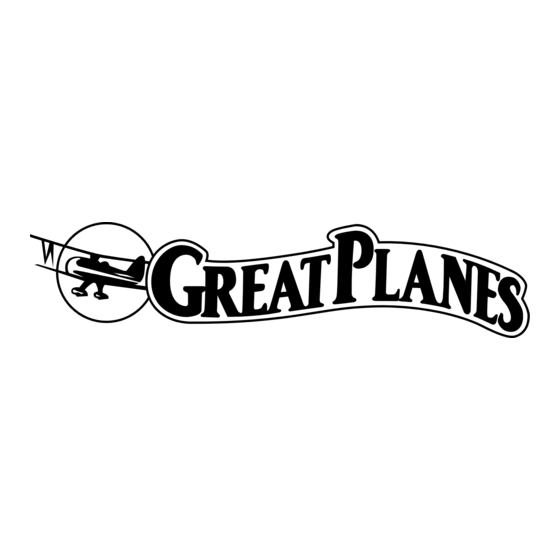GREAT PLANES FW-190 Focke Wulf Gebrauchsanweisung - Seite 13
Blättern Sie online oder laden Sie pdf Gebrauchsanweisung für Spielzeug GREAT PLANES FW-190 Focke Wulf herunter. GREAT PLANES FW-190 Focke Wulf 20 Seiten.

GET THE MODEL READY TO FLY
Check the Control Directions
❏
1. Turn on the transmitter and receiver and center the
trims. If necessary, remove the servo arms from the servos
and reposition them so they are centered. Reinstall the
screws that hold on the servo arms.
❏
2. With the transmitter and receiver still on, check all the
control surfaces to see if they are centered. If necessary, adjust
the V-bends on the pushrods to center the control surfaces.
❏
3. Arm your ESC according to the manufacturers
instructions. Make certain that the control surfaces and the
motor respond in the correct direction as shown in the
diagram. If any of the controls respond in the wrong direction,
use the servo reversing in the transmitter to reverse the servos
connected to those controls. Be certain the control surfaces
have remained centered. Adjust if necessary.
Set the Control Throws
Use a Great Planes AccuThrow
measure and set the control throw of each control surface as
indicated in the chart that follows. If your radio does not have
dual rates, we recommend setting the throws at the low
rate, or sport rate setting. Note: The 3D throws
recommended are extreme throws and should only be flown
by experienced pilots. They are very sensitive and could
cause the plane to seem uncontrollable to a novice pilot.
Sport rates are perfect, and recommended for, combat and
general aerobatic flight.
™
(or a ruler) to accurately
Note: The throws are measured at the widest part of the
elevators, rudder and ailerons.
These are the recommended control surface throws:
High Rate/3D Rate
ELEVATOR:
3-1/2" [89 mm] up
3-1/2" [89 mm] down 1-1/2" [38 mm] down
RUDDER:
3-1/2" [89 mm] right 2" [51 mm] right
3-1/2" [89 mm] left
AILERONS:
3" [76 mm] up
3" [76 mm] down
IMPORTANT: The
extensively flown and tested to arrive at the throws at
which it flies best. Flying your model at these throws will
provide you with the greatest chance for successful first
flights. If, after you have become accustomed to the way
the EP FW-190 ARF flies, you would like to change the
throws to suit your taste, that is fine. However, too much
control throw could make the model difficult to control, so
remember, "More is not always better."
Balance the Model (C.G.)
More than any other factor, the C.G. (balance point) can
have the greatest effect on how a model flies, and may
determine whether or not your first flight will be
successful. If you value this model and wish to enjoy it for
many flights, DO NOT OVERLOOK THIS IMPORTANT
PROCEDURE. A model that is not properly balanced will
be unstable and possibly unflyable.
At this stage the model should be in ready-to-fly condition
with all of the systems in place.
❏
1. Use a felt-tip pen or 1/8" [3 mm]-wide tape to accurately
mark the C.G. on the top of the wing on both sides of the
fuselage. The C.G. is located 3-3/8" [86 mm] back from the
leading edge of the wing.
13
Low Rate/Sport Rate
1-1/2" [38 mm] up
2" [51 mm] left
1-5/8" [41 mm] up
1-5/8" [41 mm] down
EP
FW-190
ARF
has
been
